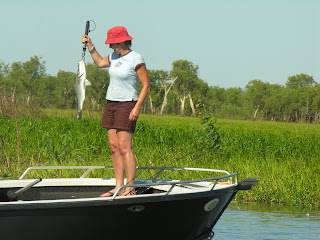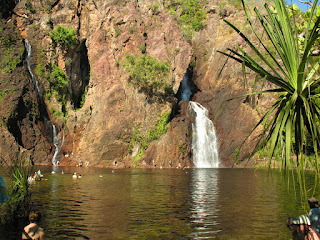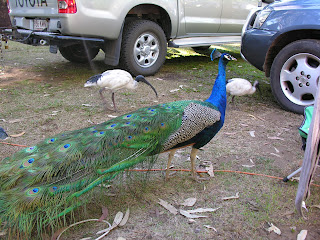




Kakadu National Park
Now Monday 12 July and we have been away for just on three months. This morning we headed out of Darwin for the Kakadu National Park., one of the few World Heritage Areas that have been listed both for their cultural and natural heritage. The park protects one of the finest and most extensive collections of rock art in the world and Australia’s Top End habitats including the entire catchment of the large tropical river, the South Alligator. Accommodation is very scarce at this time of the year and we had to book accommodation for three separate locations, two nights in Jabiru and the third in
The weather was quite hot as we headed off and there were some big bush fires in the nearby areas. After lunch at the Bark Hut Inn on the Arnhem Highway, we travelled along the Old Jim Jim Road through to the Kakadu Highway. This was 97 km of unsealed road and passed through some restricted defence areas where there were some operations in progress. The temperature rose to 34 deg C but the road was in fairly good condition. We didn’t pass any other cars, only two graders working on the road. We crossed a couple of branches of the South Alligator River, but only one had water in it and was quite manageable.



Now Monday 12 July and we have been away for just on three months. This morning we headed out of Darwin for the Kakadu National Park., one of the few World Heritage Areas that have been listed both for their cultural and natural heritage. The park protects one of the finest and most extensive collections of rock art in the world and Australia’s Top End habitats including the entire catchment of the large tropical river, the South Alligator. Accommodation is very scarce at this time of the year and we had to book accommodation for three separate locations, two nights in Jabiru and the third in
The weather was quite hot as we headed off and there were some big bush fires in the nearby areas. After lunch at the Bark Hut Inn on the Arnhem Highway, we travelled along the Old Jim Jim Road through to the Kakadu Highway. This was 97 km of unsealed road and passed through some restricted defence areas where there were some operations in progress. The temperature rose to 34 deg C but the road was in fairly good condition. We didn’t pass any other cars, only two graders working on the road. We crossed a couple of branches of the South Alligator River, but only one had water in it and was quite manageable.



We were advised to call in at the Bowali Visitor Centre and were able to pick up all the information about the areas we could visit and the walks available. From there we found our accommodation for the first night which was a “bungalow bush safari tent”, a bit up market from the last safari tent, but the ensuite was outside and a short walk along a path.
Inside it was very comfortable, fully screened and roof was tented with sails over the top. The entrance door was a bit strange as the bungalow was about a metre above the ground and it had a very high step and then a very low door. Not sure what the real reason was for this form of architecture but it made getting in and out interesting. Then during the night we had a heavy tropical downpour for a couple of hours. Just the thing you need when ensuite is outside! Next morning when Heinz went to open the car doors he noticed a “swishing” noise and found the doors which we had previously sealed for dust had taken in quite a lot of water, so the seals had to come off.
Inside it was very comfortable, fully screened and roof was tented with sails over the top. The entrance door was a bit strange as the bungalow was about a metre above the ground and it had a very high step and then a very low door. Not sure what the real reason was for this form of architecture but it made getting in and out interesting. Then during the night we had a heavy tropical downpour for a couple of hours. Just the thing you need when ensuite is outside! Next morning when Heinz went to open the car doors he noticed a “swishing” noise and found the doors which we had previously sealed for dust had taken in quite a lot of water, so the seals had to come off.


The next day, after a quick trip to see the ERA Ranger Mine, we headed up to Ubirr close to the border of Arnhem Land. There a 1 km circular track takes you past several fascinating Aboriginal rock art sites. From there you can do the steep climb up to a rocky lookout where there are views over the Nardab flood plain. Heinz went up and got some great photos.





Before we went into Ubirr we drove across the East Alligator River at Cahill’s Crossing into Arnhem Land, but didn’t proceed because we didn’t have permits. Luckily we did it then because once the tide comes up you just have to wait until it is safe to cross.
We picked up some lunch at the Border Store to have down near the river, then did the Manngarre rainforest walk which had only just reopened. The track takes you along beside the river for quite a way with some lookouts. We managed to see a couple of saltwater crocodiles in the very muddy river. Lots of information about crocodile safety around and seeing them was a timely reminder. Yet, fishermen fish quite happily from the banks being very watchful, of course. Got back in time to relax at our cabin and have a swim before dinner.
We picked up some lunch at the Border Store to have down near the river, then did the Manngarre rainforest walk which had only just reopened. The track takes you along beside the river for quite a way with some lookouts. We managed to see a couple of saltwater crocodiles in the very muddy river. Lots of information about crocodile safety around and seeing them was a timely reminder. Yet, fishermen fish quite happily from the banks being very watchful, of course. Got back in time to relax at our cabin and have a swim before dinner.



The next day we headed off to Nourlangie, stopping on our way to visit the Anbangbang Billabong, our first up close, although we had passed several along the way. It was very peaceful with lots of bird life. At Nourlangie, we saw some wonderful art sites (some are referred to as galleries), and the Anbangbang Shelter, an ancient living shelter where aboriginal people have been coming home to for about 20,000 years. We read the story of “Namarrgon” known as the Lightning Man. When bright orange and green grasshoppers start to appear the aboriginals know to seek shelter as this is a signal for the start of the severe thunderstorm season. We also visited the Jim Jim Billabong, which was a very popular fishing spot.





We had booked an afternoon cruise on the Yellow Water, near our accommodation at Cooinda. For 1-1/2 hours we cruised on the billabong, parts of the East Alligator River and over the flood plains. The area is truly beautiful and we had an entertaining guide. Within a couple of minutes we saw the first of many crocodiles, the second one on a bank with a barramundi in its mouth. The birdlife was prolific and we saw so many varieties. Twice we saw nests where a mother was feeding its baby. The first was a Jabiru and had one baby. The second was a long necked egret who had at least two and possibly three babies to feed. Many white bellied sea-eagles flew overhead, one trying to catch a fish in front of us. Also saw many whistling kites, egrets, brightly coloured jacanas, honey coloured ducks, magpie geese and others we can’t remember the names. There are also quite a few wild horses in the wetlands. We also passed a fishing boat where a lady had just caught a fair sized barramundi, and she was very excited. It was a warm sunny day with clear blue skies and the cruise was just as advertised in the brochures.







There were many walks or 4WD tracks we didn’t attempt and you could spend at least a week in the area. As we headed for Katherine we were able to do a couple more of the park walks on the way. The first was a 11 km 4WD drive to the Maguk plunge pool, where the track started off through monsoon forest and then followed a sandy and rocky creek to a waterfall and waterhole. I was able to do the track about half way but let Heinz go ahead when we came to a slippery rocky creek crossing and then a rocky path. It was a very pretty walk through the forest alongside the river, and I enjoyed sitting on the large rocks in the sun and talking to other walkers on the track.



From there we drove down to the Gunlom at Waterfall Creek. This was a 37 km gravel road but in good condition. The picnic grounds were beautiful with large grassy areas and lots of trees, and a short path lead to a beautiful pool where people were swimming. Normally during the week and some nights the rangers give talks on aboriginal culture, bush tucker and the community, but we read of the death of an Aboriginal Elder and the rangers were not available and the information centre was closed. The caravan park seemed to have very good facilities and there was a kiosk serving fresh lunches which we enjoyed under the shade of a salmon gum.




We headed off to spend the night in Pine Creek where again accommodation is at a premium due to work being done by Gold Mining and Iron Ore companies in the area. However, we managed to get a motel room and a good meal. An interesting young Scottish man joined us at dinner and he is cycling from Darwin to Adelaide (some 3000 km). He was having a day or so R & R before tackling the next section. Although nights were cool, the daytime temperatures were around 30 deg. C, but it was expected to get cooler as he cycled south

On our way to Katherine the next day we drove into Edith Falls in another area of the Nitmuluk National Park, spending a short time at the park (again lots of grass and trees) and the pool. We didn’t do any of the walks there but believe they are well worth doing and many people spend several days there in the caravan park.
































